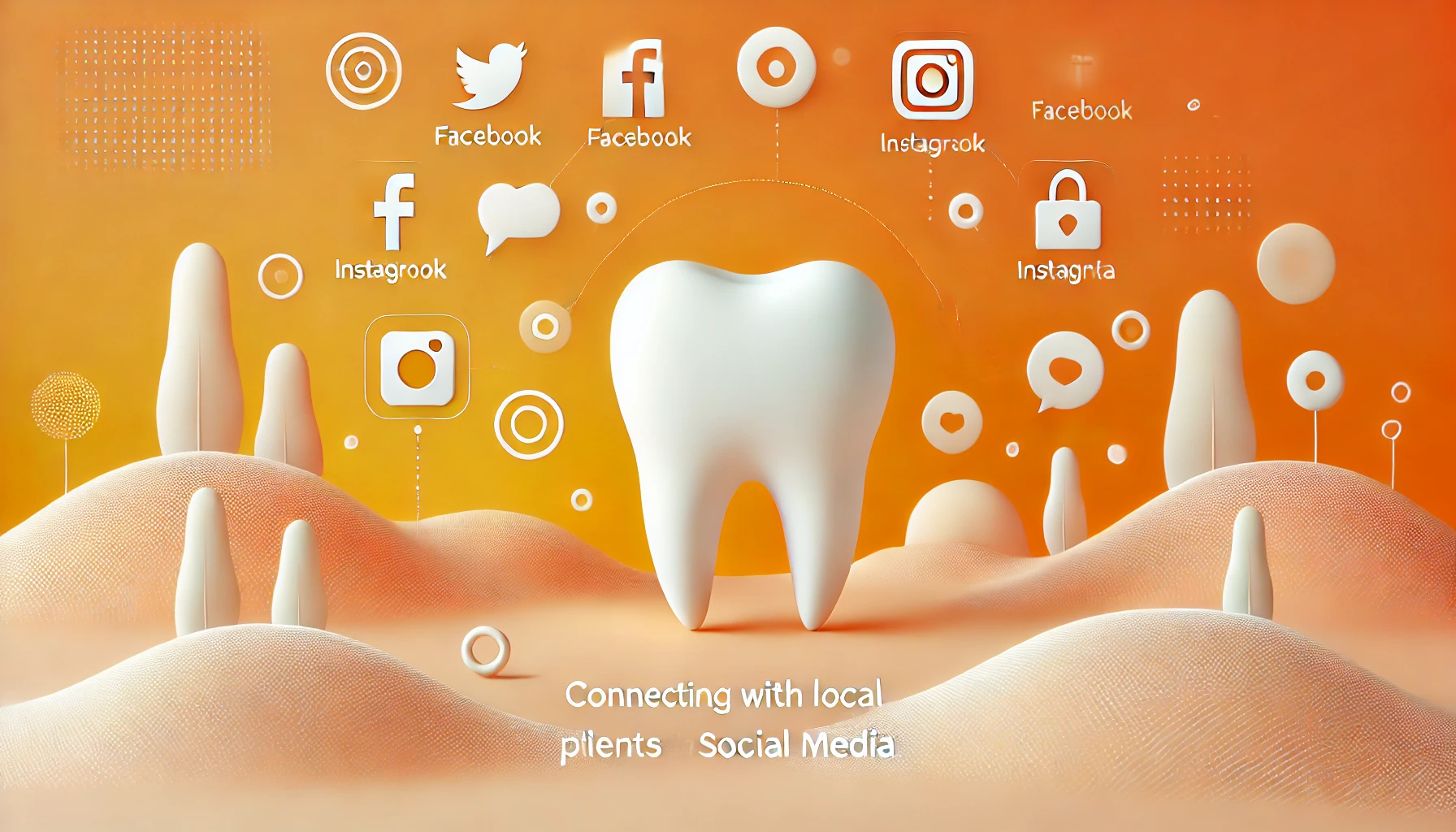Introduction
The dental industry in Delhi is rapidly evolving, driven by an increasing awareness of oral health among the population. With a growing middle class and urbanization, more people are prioritizing dental care, leading to a higher demand for dental services. According to a recent survey, over 70% of urban Indians consider dental health crucial, yet many still do not seek regular dental check-ups. This gap represents an opportunity for dental practitioners to reach out to local patients effectively.
In this digital age, social media has transformed how healthcare providers, including dentists, connect with their patients. Platforms such as Facebook, Instagram, and Twitter offer dentists the opportunity to engage with current and potential patients in a more personal and direct manner. Social media can serve as a bridge, allowing dental practices to communicate their services, share valuable information, and build relationships within their communities.
The importance of social media in the dental field cannot be overstated. A well-maintained social media presence not only enhances visibility but also fosters trust and credibility among potential patients. With many people turning to social media for health-related information and recommendations, dentists who leverage these platforms effectively can significantly enhance their patient base. In this article, we will explore how Delhi dentists can harness the power of social media to connect with local patients and ultimately grow their practices.
Understanding Social Media
Social media refers to a variety of online platforms that allow users to create and share content or participate in social networking. Popular social media platforms include Facebook, Instagram, Twitter, LinkedIn, and newer entrants like TikTok. Each platform has its unique audience and features, making it crucial for dentists to understand where to focus their efforts.
In India, social media usage has surged in recent years, with over 600 million active users. Among these, a significant portion belongs to urban areas, making platforms like Facebook and Instagram ideal for reaching potential patients in Delhi. Research indicates that nearly 90% of social media users trust recommendations from friends and family, highlighting the importance of building a positive online reputation.
The impact of social media on healthcare is profound. Patients increasingly seek information about healthcare providers online, including reviews, treatment options, and patient experiences. According to a survey, 77% of patients use social media to research their healthcare providers, and 50% have engaged with a provider through social media. This trend underscores the need for dental practices to establish a robust online presence.
Successful social media campaigns in healthcare often focus on educating patients, building community, and fostering engagement. For example, campaigns that share educational content, such as dental hygiene tips or common procedures, can position dentists as trusted experts in their field. Moreover, sharing patient testimonials or success stories can further enhance credibility and attract new patients.
In summary, understanding the dynamics of social media is crucial for Delhi dentists aiming to connect with local patients. By leveraging these platforms effectively, dental practices can not only enhance their visibility but also foster trust and engagement with their communities.
Building an Online Presence
Creating a professional online presence is the first step for dentists looking to leverage social media effectively. This begins with setting up profiles on various platforms, ensuring they are complete and visually appealing. Each profile should include a clear profile picture, ideally the dental practice logo or a professional photo of the dentist. The bio should succinctly describe the services offered, location, and contact information. Including a link to the practice’s website is also essential for directing traffic and inquiries.
Choosing the right platforms is critical for effective engagement. Facebook is a versatile platform that allows dentists to share a mix of content types, including photos, videos, and articles. With its extensive user base, it is an ideal starting point for most practices. Instagram, on the other hand, is highly visual and perfect for sharing before-and-after images of dental work, educational infographics, and engaging short videos. Twitter can be used for quick updates, sharing news related to dental health, or engaging in discussions with patients and other professionals.
It’s essential to understand the differences in audience engagement across platforms. For example, younger demographics tend to favor Instagram and TikTok, while older patients may prefer Facebook. Tailoring content to fit the audience on each platform is crucial for maximizing reach and engagement. Dentists should consider the type of content that resonates with their target demographic, such as informative posts for older patients and fun, engaging visuals for younger audiences.
To enhance their online presence, dentists should also consider creating a practice website if they haven’t already. A website serves as a central hub for all online activities and provides a platform for sharing comprehensive information about services, patient testimonials, and contact details. Moreover, having a blog section on the website can boost search engine visibility and provide content for social media sharing.
In addition to establishing profiles and creating content, dentists should actively engage with their audience. This involves responding to comments and messages promptly, which not only helps build a rapport with patients but also shows that the practice values patient interaction. Regularly updating social media profiles with fresh content and engaging posts will keep followers interested and informed about the practice.
Overall, building an online presence requires careful planning and execution. By creating professional profiles on the right platforms and maintaining an active, engaging presence, Delhi dentists can significantly enhance their visibility and connect with local patients effectively.
Content Strategy for Dentists
A robust content strategy is vital for dentists looking to make the most of social media. The type of content shared can significantly influence patient engagement and the practice’s overall reputation. Here are key components of a successful content strategy.
First, dentists should focus on educational content. Sharing valuable information, such as dental hygiene tips, the importance of regular check-ups, or explanations of common procedures, positions dentists as knowledgeable professionals. Posts could include infographics about proper brushing techniques, videos demonstrating flossing, or articles discussing the latest advancements in dental technology. This not only informs patients but also builds trust and authority.
Promotional content is also essential for engaging with potential patients. Sharing information about special offers, new services, or upcoming events can attract attention and encourage bookings. For instance, a dental clinic might run a promotional campaign offering discounts on teeth whitening for new patients. Such offers can generate excitement and drive traffic to the practice.
Patient testimonials and case studies are powerful tools for building credibility. Sharing real stories from satisfied patients, including before-and-after photos (with their permission), can significantly influence potential patients’ perceptions. Video testimonials can be particularly effective, as they add a personal touch and authenticity that resonates with viewers. Dentists should encourage satisfied patients to share their experiences on social media and tag the practice, helping to spread positive word-of-mouth.
Visual content plays a critical role in social media engagement. High-quality images and videos are more likely to capture attention and drive interaction. Dentists should invest in good photography to showcase their office environment, staff, and equipment, as well as patient transformations. Regularly posting engaging visual content, such as behind-the-scenes looks at the practice or fun dental facts, can keep the audience entertained and informed.
Creating a content calendar can streamline the posting process and ensure a consistent flow of content. A calendar allows dentists to plan posts in advance, align content with important dates (such as National Dental Health Month), and maintain a balance between educational and promotional material. There are various tools available, such as Hootsuite or Buffer, that can help schedule and manage social media posts effectively.
Lastly, it’s essential to monitor the performance of the content shared. Dentists should pay attention to which posts receive the most engagement and adapt their strategies accordingly. By analyzing data and feedback, practices can continually refine their content strategy to meet the interests and needs of their audience.
In conclusion, a well-thought-out content strategy is crucial for dentists aiming to connect with local patients through social media. By focusing on educational, promotional, and visual content, and utilizing a content calendar, dental practices can enhance engagement, build trust, and ultimately grow their patient base.
Engaging with Local Patients
Engaging with local patients is a vital aspect of social media for dentists. Building a community online not only strengthens the practice’s relationship with existing patients but also attracts new ones. Here are effective strategies for fostering engagement on social media.
First and foremost, interactive content can significantly boost engagement. Dentists can create polls, quizzes, or surveys related to dental health to encourage followers to participate. For example, a simple quiz about common dental myths can spark interest and lead to discussions in the comments. Live Q&A sessions on platforms like Facebook or Instagram can also be an excellent way to engage directly with the audience, allowing patients to ask questions and receive real-time answers from the dentist.
Responding to comments and messages promptly is crucial for building rapport with patients. Social media is a two-way street, and engaging with followers shows that the practice values their input and concerns. Dentists should aim to reply to comments on their posts and private messages as quickly as possible, which helps foster a sense of community and encourages more patients to reach out.
Utilizing local SEO strategies is another effective way to connect with local patients. By incorporating location tags and hashtags in posts, dentists can increase their visibility within the local community. For example, using hashtags like #DelhiDentist or #DentalCareDelhi can help reach individuals searching for dental services in the area. Additionally, tagging the location of the practice in posts can attract local users who might be browsing nearby services.
Collaborating with local businesses and influencers can also enhance visibility and engagement. Partnering with local health and wellness businesses, such as gyms or health food stores, can create cross-promotional opportunities. For instance, a dentist could host a joint event with a local health store, offering dental check-up discounts or free consultations. Such collaborations can introduce the practice to new audiences and generate excitement in the community.
Influencer marketing is another avenue worth exploring. Dentists can collaborate with local influencers who have a significant following in the health and wellness space. Influencers can share their experiences at the dental practice, showcase services, or provide endorsements. This strategy can significantly boost the practice’s visibility among potential patients who trust the influencer’s recommendations.
Lastly, dental practices should actively participate in community events and initiatives. Sponsoring local events, health fairs, or school activities can enhance the practice’s reputation and establish it as a community-oriented business. Sharing updates about community involvement on social media further reinforces the practice’s commitment to local health and well-being.
In summary, engaging with local patients through social media requires a proactive approach. By creating interactive content, responding to audience inquiries, utilizing local SEO strategies, collaborating with local businesses, and participating in community initiatives, Delhi dentists can effectively build a strong online community and attract new patients.
Advertising on Social Media
Paid advertising on social media presents an excellent opportunity for dentists in Delhi to reach a larger audience and attract new patients. Understanding the various advertising options available on platforms like Facebook and Instagram is crucial for crafting effective campaigns.
Social media platforms offer a range of advertising formats, including image ads, video ads, carousel ads, and stories ads. Each format has its unique benefits and can be tailored to meet specific marketing goals. For instance, video ads can effectively showcase dental procedures, while carousel ads can highlight different services or promotions offered by the practice. Dentists should experiment with different ad formats to determine what resonates best with their audience.
Targeted advertising is one of the standout features of social media marketing. Dentists can define their audience based on various criteria, including age, location, interests, and behaviors. For example, a dentist in Delhi might target ads specifically to individuals aged 25-50 living within a 10-kilometer radius of their practice. This level of targeting ensures that advertising budgets are spent efficiently, reaching those most likely to require dental services.
Creating effective ads is critical for capturing the attention of potential patients. High-quality visuals are essential; images should be clear, professional, and engaging. The ad copy should be concise and compelling, clearly communicating the benefits of the service or promotion. A strong call-to-action (CTA) is vital, encouraging viewers to book an appointment, visit the website, or learn more about the services offered.
Tracking ad performance is another key aspect of social media advertising. Most platforms provide analytics tools to monitor engagement metrics such as click-through rates, impressions, and conversions. By analyzing this data, dentists can assess the effectiveness of their campaigns and make necessary adjustments to improve performance. For instance, if an ad is underperforming, dentists might consider changing the visuals, adjusting the target audience, or modifying the ad copy.
Budget management is also crucial in social media advertising. Dentists should establish a clear budget for each campaign and allocate funds based on the performance of previous ads. Starting with a small budget allows practices to test different approaches and scale up successful campaigns.
Moreover, retargeting is a powerful strategy that allows dentists to reach individuals who have previously interacted with their content or visited their website. Retargeting ads can remind potential patients of the services offered and encourage them to take action, such as booking an appointment.
In conclusion, advertising on social media is a valuable tool for dentists in Delhi looking to grow their practices. By leveraging targeted advertising, creating compelling content, tracking performance, and managing budgets effectively, dental practices can maximize their reach and attract new patients.
Measuring Success
Measuring success in social media marketing is essential for dentists to understand the effectiveness of their efforts and make informed decisions for future campaigns. By tracking key performance indicators (KPIs), dental practices can gain insights into what works and what needs improvement.
Key performance indicators for social media can include metrics such as engagement rates (likes, comments, shares), click-through rates (CTR), conversion rates, follower growth, and reach. Each of these metrics provides valuable information about how well the content resonates with the audience and how effectively it drives desired actions, such as website visits or appointment bookings.
Engagement rates are a critical metric to monitor, as they reflect how well the audience interacts with the content. High engagement rates indicate that the content is relevant and appealing to followers, while low engagement may suggest a need for content adjustment. Tracking engagement allows dentists to identify the types of posts that generate the most interest and replicate successful strategies.
Click-through rates measure how effectively social media posts encourage users to take action, such as visiting a website or booking an appointment. A low CTR may indicate that the call-to-action (CTA) needs to be more compelling or that the audience may not find the content relevant. By analyzing CTR alongside engagement rates, dentists can gain a comprehensive understanding of their content’s effectiveness.
Conversion rates are crucial for assessing the success of specific campaigns. This metric measures the percentage of users who complete a desired action, such as filling out a contact form or scheduling an appointment. By tracking conversions, dentists can evaluate the ROI of their social media efforts and determine which campaigns are driving tangible results.
Tools for measuring success are widely available and can simplify the tracking process. Platforms like Facebook Insights, Instagram Insights, and Google Analytics provide detailed analytics to help dentists monitor performance. These tools offer valuable data, including demographic information about followers, engagement metrics, and website traffic sources. Utilizing these insights can inform future content strategies and advertising efforts.
Adjusting strategies based on performance metrics is essential for continuous improvement. Dentists should regularly review analytics and identify trends or patterns in engagement. For instance, if video content consistently performs better than static images, practices should prioritize creating more video content. Similarly, if certain topics generate higher engagement, dentists should focus on those areas in their future content.
In conclusion, measuring success in social media marketing is critical for dentists looking to connect with local patients. By monitoring key performance indicators, utilizing analytics tools, and adjusting strategies based on data, dental practices can enhance their social media efforts and grow their patient base effectively.
Conclusion
In summary, social media presents an unparalleled opportunity for Delhi dentists to connect with local patients and grow their practices. By understanding the dynamics of social media, building a professional online presence, developing a robust content strategy, engaging with the local community, utilizing advertising options, and measuring success, dentists can create a powerful online presence that resonates with their target audience.
The benefits of social media for dental practices are numerous. It enhances visibility, builds trust, and fosters engagement with current and potential patients. As more individuals turn to social media for health-related information and recommendations, it becomes increasingly important for dentists to establish and maintain an active presence on these platforms.
Moreover, social media allows dental practices to showcase their expertise, share valuable information, and humanize their brand. By sharing educational content, patient testimonials, and engaging visuals, dentists can position themselves as trusted professionals within their communities. This not only attracts new patients but also fosters loyalty among existing ones.
As the dental landscape in Delhi continues to evolve, embracing social media will be essential for staying competitive. The ability to connect with patients on a personal level and provide valuable information can set a practice apart in a crowded market. Dentists who leverage social media effectively can not only increase their patient base but also cultivate lasting relationships with their community.
For dentists looking to enhance their social media presence, the journey begins with a commitment to consistent engagement and valuable content. It is essential to stay updated with social media trends and adapt strategies accordingly. As the digital landscape changes, so too should the approach to connecting with patients.
In conclusion, social media is not just a marketing tool; it is a vital component of modern dental practice management. By embracing the opportunities it presents, Delhi dentists can connect with local patients in meaningful ways, ultimately leading to the growth and success of their practices. Now is the time for dentists to take action, leverage social media, and reap the benefits of a thriving online community.





